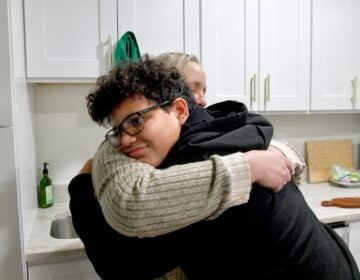Mayor Kenney returns from Puerto Rico disappointed by the federal government’s work
On his first official visit to Puerto Rico, Mayor Jim Kenney was impressed by island residents’ resiliency and strength.
Listen 2:17
Mayor Kenney toured San Juan neighborhoods with Mayor Carmen Yulín Cruz. (image via Mayor Cruz press office)
On his first official visit to Puerto Rico, Mayor Jim Kenney was impressed by island residents’ resiliency and strength. “There’s a confidence that they have, and a decency that they have, that they don’t complain too much about what’s going on around them,” he said.
But at the same time, Philadelphia’s mayor was shocked by the way the federal government has ignored their needs.
“I found it very unsettling to be there because … they’re United States citizens, we should be helping them. We’re not, we’re not,” Kenney said. “And things [like] the power grid is not back up, you know, two-thirds of the island is still at intermittent power and lights. … It’s just really a shame.”
Kenney spent two days last week in San Juan, the commonwealth’s capital, on a Mayor Exchange program led by the Open Society Foundations that pairs mayors from cities on the mainland with mayors on the island.
As part of the program, San Juan’s mayor, Carmen Yulín Cruz, is scheduled to visit Philadelphia sometime in June, although the date has not been yet. Efforts to reach her Wednesday were not successful.
During his time in Puerto Rico, Kenney toured San Juan with Yulín Cruz, visiting different neighborhoods and after-school programs.
Lack of or inconsistent electric power in the aftermath of Hurricane Maria is still the biggest challenge that San Juan, and the whole island, faces. Some buildings have blue tarps on their roofs eight months after Maria hit the island in September, and people are still struggling, according to the mayor. But at the same time, Kenney said, he felt a sense of normalcy — and tourism — coming back.
“You start seeing the first views of greenery again. Because the salt water that came on shore killed all the vegetation … it’s almost like a forest fire, and now that is starting to grow back,” Kenney said. “That’s helpful, mentally helpful.”
He strongly criticized Puerto Rico’s government, saying it is not doing much to prepare for another natural disaster. Most of the work, Kenney said, is being done by mayors like Yulín Cruz, whom he praised as “refreshing and fearless.” What surprised him the most, he said, was that the vast majority of locally generated tax revenue goes to island’s government.
“Of their real estate tax, they keep 20 percent, and the state gets 80. To do what with? I don’t know what they’re doing,” Kenney said. “I don’t think the commonwealth government or the governor has done anything, other than trying to cozy up to [President] Trump, which didn’t work apparently.”
Kenney says San Juan’s mayor is doing everything she can to prepare her city for this year’s hurricane season. But without the federal government’s help, they don’t have the tools or the infrastructure needed to face another big storm like Maria, he said, and people are still emotionally traumatized.
“People will start talking to you and then drift off back into the hurricane mode and start … you can see their minds are wandering,” Kenney said. “So hopefully, they won’t be hit another time. I don’t think they can survive another large-scale hurricane or other kind of natural disaster.”
Philadelphia will be connecting San Juan with the city’s Water Department for water-management support, and helping the island’s capital move toward solar energy. Kenney said one of the lessons learned after the hurricane was that the housing stock wasn’t prepared for such a disaster. Now, he said, San Juan is looking into different kinds of prefabricated housing that can be built and stored, then used in case of emergencies. He was present when Yulín Cruz announced the construction of six emergency houses.
“I would love for Philadelphia to be a manufacturer of temporary or disaster housing, through the use of [former] shipping containers — [for] which the technology is there and it’s easy to build them indoors — and that can become a manufacturing hub for us,” Kenney said.
After Hurricane Maria, more than 900 Puerto Rican families fled to Philadelphia, putting the local emergency-management community and the city in a situation they’ve never been in before — responding to a disaster more than 1,500 miles away with almost no federal resources.
If something of that scale should happen, Philadelphia is better prepared to respond now, Kenney said. But he made clear that emergency management for the island is a federal responsibility.
“We’re trying to do our best to take care of everybody, and we’ll take care of those who are refugees if it happens again,” he said. “But you know, the federal government has the wherewithal to do better, much better than they’ve done, and they refused to do it, and I think a lot of it has to do with the fact that … they’re not white people.”
Although the local Puerto Rican community recognizes and appreciates the work Philadelphia has been doing to face the crisis caused by Hurricane Maria, some organizers and grassroots organizations have said that Kenney could be doing more.
“I don’t know what else I’m supposed to do. I mean, we set up the disaster center, and we kept it open for a long period of time, we’re placing people in housing, we’re providing people with clothing and other things,” he said. “I think those people who are questioning my lack of vocalness should be questioning the federal government, not me.”
WHYY is your source for fact-based, in-depth journalism and information. As a nonprofit organization, we rely on financial support from readers like you. Please give today.







